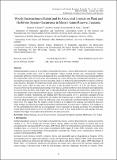| dc.description.abstract | Habitat degradation caused by woody plant encroachment has been a common phenomenon in savanna ecosystems.
An increasing woody plant cover in open grassland reduces grazing grounds and, consecutively, impacts
mammalian herbivores, but structural changes and their associated impact have rarely been assessed and quantified.
We analyzed the extent of woody plant encroachment via remote sensing and used transects and plots to assess
encroaching woody plant species and their associated impacts on herbaceous plant and herbivore species in Maswa
Game Reserve, Tanzania. We found that woody plant cover had increased by 0.5% to 2.6% per annum over the
last thirty years, while in other parts of the park it has decreased by 0.5% to 1.5% per annum. Acacia
drepanolobium was the dominant encroaching woody species, and the number of stems in heavily encroached sites
was seven times and three times higher than in open grassland and at medium encroached sites, respectively. In
encroached plots, grazer and mixed feeder species occurrence were reduced while the presence of browser species
was slightly elevated. Furthermore, our findings show that bare ground cover is positively correlated with an
increase of woody plant cover. Additionally, the number of herbaceous species slightly increased with the increase
of woody plant encroachment, while the herbaceous cover was negatively correlated with the increase of woody
plant cover. We suggest that fire regimes should be taken up to suppress the ongoing encroachment processes
while strongly encroached sites might need mechanical intervention to control dense vegetation. This emphasis is
on fire, particularly prescribed fire as a management tool of vegetation in Savanna ecosystem. We conclude that,
woody plant encroachment is driven by different factors such as fire, mega-herbivores and topology that may
interactively trigger woody plant encroachment in Savanna ecosystem. | en_US |

